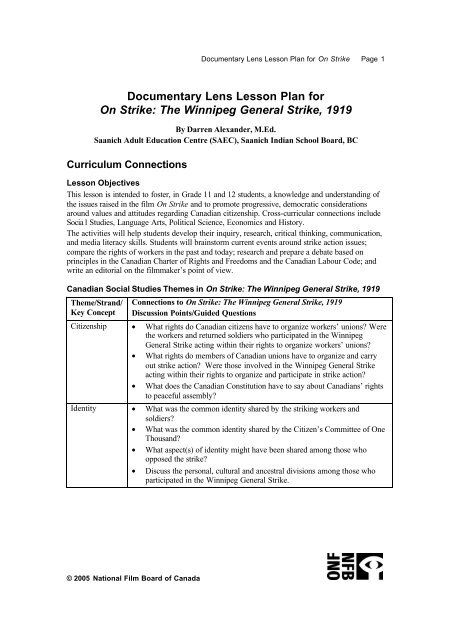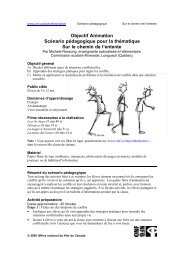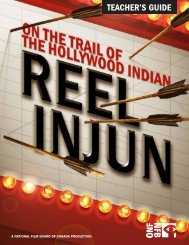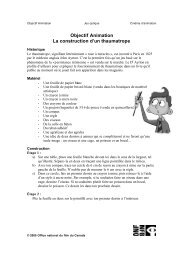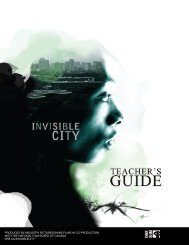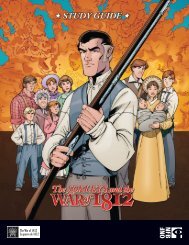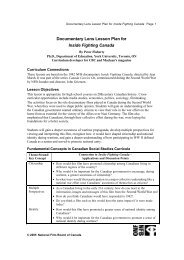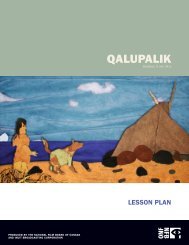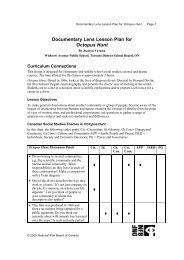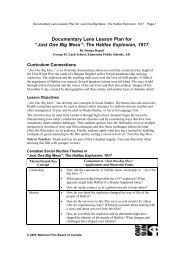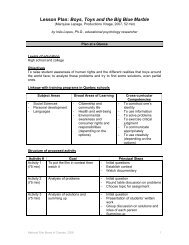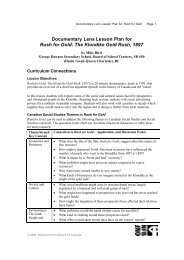Documentary Lens Lesson Plan for On Strike - Office national du film ...
Documentary Lens Lesson Plan for On Strike - Office national du film ...
Documentary Lens Lesson Plan for On Strike - Office national du film ...
Create successful ePaper yourself
Turn your PDF publications into a flip-book with our unique Google optimized e-Paper software.
<strong>Documentary</strong> <strong>Lens</strong> <strong>Lesson</strong> <strong>Plan</strong> <strong>for</strong> <strong>On</strong> <strong>Strike</strong> Page 1<strong>Documentary</strong> <strong>Lens</strong> <strong>Lesson</strong> <strong>Plan</strong> <strong>for</strong><strong>On</strong> <strong>Strike</strong>: The Winnipeg General <strong>Strike</strong>, 1919By Darren Alexander, M.Ed.Saanich A<strong>du</strong>lt E<strong>du</strong>cation Centre (SAEC), Saanich Indian School Board, BCCurriculum Connections<strong>Lesson</strong> ObjectivesThis lesson is intended to foster, in Grade 11 and 12 students, a knowledge and understanding ofthe issues raised in the <strong>film</strong> <strong>On</strong> <strong>Strike</strong> and to promote progressive, democratic considerationsaround values and attitudes regarding Canadian citizenship. Cross-curricular connections includeSocia l Studies, Language Arts, Political Science, Economics and History.The activities will help students develop their inquiry, research, critical thinking, communication,and media literacy skills. Students will brainstorm current events around strike action issues;compare the rights of workers in the past and today; research and prepare a debate based onprinciples in the Canadian Charter of Rights and Freedoms and the Canadian Labour Code; andwrite an editorial on the <strong>film</strong>maker’s point of view.Canadian Social Studies Themes in <strong>On</strong> <strong>Strike</strong>: The Winnipeg General <strong>Strike</strong>, 1919Theme/Strand/Key ConceptConnections to <strong>On</strong> <strong>Strike</strong>: The Winnipeg General <strong>Strike</strong>, 1919Discussion Points/Guided QuestionsCitizenship • What rights do Canadian citizens have to organize workers’ unions? Werethe workers and returned soldiers who participated in the WinnipegGeneral <strong>Strike</strong> acting within their rights to organize workers’ unions?• What rights do members of Canadian unions have to organize and carryout strike action? Were those involved in the Winnipeg General <strong>Strike</strong>acting within their rights to organize and participate in strike action?• What does the Canadian Constitution have to say about Canadians’ rightsto peaceful assembly?Identity • What was the common identity shared by the striking workers andsoldiers?• What was the common identity shared by the Citizen’s Committee of <strong>On</strong>eThousand?• What aspect(s) of identity might have been shared among those whoopposed the strike?• Discuss the personal, cultural and ancestral divisions among those whoparticipated in the Winnipeg General <strong>Strike</strong>.© 2005 National Film Board of Canada
<strong>Documentary</strong> <strong>Lens</strong> <strong>Lesson</strong> <strong>Plan</strong> <strong>for</strong> <strong>On</strong> <strong>Strike</strong> Page 2Theme/Strand/Key ConceptChange andContinuityCulture andCommunityThe Land:People andPlacesIndivi<strong>du</strong>als,Societies, andEconomicDecisionsGlobalConnectionsPower andGovernanceConnections to <strong>On</strong> <strong>Strike</strong>: The Winnipeg General <strong>Strike</strong>, 1919–DiscussionPoints/Guided Questions• What are some examples of the rights and protections that Canadianworkers enjoy today? Which of these rights do you think came aboutbecause of strike actions or other <strong>for</strong>ms of civil disobedience in the past?• How have conditions improved or worsened <strong>for</strong> Canadian workers,regarding their rights and protections since the time of the WinnipegGeneral <strong>Strike</strong>?• How do current wages and incomes relate to the current cost of living inyour part of Canada? How does this compare to other regions of thecountry?• In the <strong>film</strong> there is reference to the gap between the haves and the havenotsin Winnipeg as contributing to the strike. Has this gap widened ornarrowed in Canada since 1919?• What is socialism? How did it play a role in the Winnipeg General <strong>Strike</strong>?• How did events in Russia, partic ularly the Bolshevik revolution, inspireworkers in Winnipeg?• What cultural ties, if any, existed between Russia and those who wouldhave supported the Winnipeg General <strong>Strike</strong>?• At the beginning of the documentary, a voiceover refers to the General<strong>Strike</strong> as “a war of ideologies.” What opposing ideologies, or worldviews,were being represented by those who were <strong>for</strong> and against the strike?• In the documentary a woman’s voice is heard speaking to how the factoryowners and bosses lived on one side of Winnipeg (the south) and how theimmigrants and workers lived on the other. Why do you think that ownersand workers lived literally “on opposite sides of the track”?• Why was Winnipeg such a hotbed of in<strong>du</strong>strial activity leading up toWorld War I? What conditions particular to this city and its citizenscontributed to such in<strong>du</strong>strial and economic activity?• Solidarity is key in union organizations, and it is mentioned in the <strong>film</strong>.What does this concept mean?• How can it in<strong>du</strong>stry owners and bosses profit from a war abroad?• Are economic decisions always ethical? Discuss the ethical concerns thatare raised from war “profiteering.”• Much of the in<strong>du</strong>stry in Winnipeg leading up to the strike was contributingto and profiting from the war overseas. What were the pro<strong>du</strong>cts beingmanufactured? Where were they being shipped?• How are in<strong>du</strong>stries and corporations contributing to wars in the worldtoday? Are there in<strong>du</strong>stries or corporations in Canada that are profitingfrom such conflicts today?• What kind of labour codes existed to secure and protect workers’ rights inCanada at the time of the Winnipeg <strong>Strike</strong>?• Which jurisdiction(s) of government contend(s) with labour issues inCanada? Name some examples of current labour issues in your province.© 2005 National Film Board of Canada
<strong>Documentary</strong> <strong>Lens</strong> <strong>Lesson</strong> <strong>Plan</strong> <strong>for</strong> <strong>On</strong> <strong>Strike</strong> Page 3Theme/Strand/Key ConceptConnections to <strong>On</strong> <strong>Strike</strong>: The Winnipeg General <strong>Strike</strong>, 1919–DiscussionPoints/Guided Questions• Why were all three levels of government opposed to the strike andinsistent that “it had to be quashed at all costs”?• Was it reasonable <strong>for</strong> the press and the government to infer that workersrallying <strong>for</strong> their rights in Winnipeg had direct ties to Russian Bolsheviksand were planning a revolution?• Who condoned the use of “special <strong>for</strong>ces” of untrained “police” to quashpeaceful assemblies of workers’ unions? Was this fair and democratic?Assessment Strategies• Critical thinking, ACTIVITY 2, Who’s Right?: assessing in<strong>for</strong>mation considering context,bias and objectivity; synthesizing in<strong>for</strong>mation on historical and contemporary issues to reachan in<strong>for</strong>med position.• Communication skills, ACTIVITY 1, Why <strong>Strike</strong>?: participation in group brainstorming andclear communication of ideas; ACTIVITY 2, Who’s Right?: communicating effectively toexpress point of view; using debate to persuasively express an in<strong>for</strong>med viewpoint on anissue.• Research skills, ACTIVITY 5, Researching <strong>Strike</strong> Action: drawing conclusions based onresearch and evidence.• Media literacy, ACTIVITY 3, Media Literacy, Writing an Editorial: examining thetechniques a <strong>film</strong>maker uses to persuasively communicate a message.Materials and Resources• History of Winnipeg General <strong>Strike</strong> .• “<strong>Strike</strong> Action” description and definitions .• Canadian Charter of Rights and Freedoms .• Canadian Labour Code .Activities <strong>for</strong> <strong>On</strong> <strong>Strike</strong>Intro<strong>du</strong>ctory ActivitiesACTIVITY 1: Why <strong>Strike</strong>?Intro<strong>du</strong>ce the term strike action, using the definition found in the second source in the Materialsand Resources above:<strong>Strike</strong> action (or simply a strike) is the mass refusal by groups of workers to per<strong>for</strong>mwork. <strong>Strike</strong>s first became important <strong>du</strong>ring the in<strong>du</strong>strial revolution, when masslabour became important in factories and mines. In most countries they were quicklymade illegal as factory owners had far more political power than the workers. Mostwestern countries legalized striking partially in the late nineteenth or early twentiethcentury.From Wikipedia.org at http://en.wikipedia.org/wiki/<strong>Strike</strong>_actionAsk students what they know about recent strike actions that have been covered in local or<strong>national</strong> media.© 2005 National Film Board of Canada
<strong>Documentary</strong> <strong>Lens</strong> <strong>Lesson</strong> <strong>Plan</strong> <strong>for</strong> <strong>On</strong> <strong>Strike</strong> Page 4<strong>On</strong>ce they have this background, ask students to brainstorm, either as a class or in small groups,the reasons why people go on strike. Urge them to be specific. For example, if students suggestpoor working conditions, as them to consider the details:• Is the work environment dangerous? Explain: Not enough light? Unsafe machinery? Toxicmaterials? Repetitive stress syndrome?Or, if students suggest not enough pay, ask:• What is a reasonable rate of pay? What is a living wage? Who decides “how much isenough”? How does this relate to cost of living?Developing Concepts and Applying what You’ve LearnedACTIVITY 2: Who’s Right?Step 1: As students watch <strong>On</strong> <strong>Strike</strong>, ask them to notice the way the story is told—throughremembrances of those who had first-hand experience in the Winnipeg General <strong>Strike</strong>. Speakerafter speaker reminds the viewer that there were two sides to this conflict. <strong>On</strong>e person suggests itwas “the big fella versus the little fella.” Another says that it was the “bosses” against “the rest ofus.”Ask students to think about whether or not the federal government’s intervention in the strike wasreasonable, democratic and respectful of the rights of the striking workers. Of course, workers’rights have evolved over time, which is taken up in step 2 below.Step 2: Ask students to look at the Canadian Charter of Rights and Freedoms (online athttp://laws.justice.gc.ca/en/const/annex_e.html#I), which is part of the Canadian Constitution.• If the Winnipeg General <strong>Strike</strong> were to occur today, what would be different about thegovernment reactions?This important document should be helpful in deciding if, by today’s standards, the citizens ofWinnipeg were within their constitutional rights to gather, to organize and to <strong>for</strong>m unions.Similarly, the Canadian Labour Code is another relevant document, since it outlines the rights ofboth workers and employers, including issues regarding strike action. The current Labour Codehas obviously been updated since 1919, but students can use it to decide if by today’s standards,the workers of Winnipeg were within their rights to unionize and strike. Of particular relevanceare the sections on In<strong>du</strong>strial Relations, particularly the brief portion relating toEmployee/Employer Freedoms (http://laws.justice.gc.ca/en/L-2/17169.html#rid-17214).Step 3: Divide the class into two groups. <strong>On</strong>e half researches the Canadian Charter of Rights andFreedoms, particularly the first four sections, i.e., Guarantee of Rights and Freedoms,Fundamental Freedoms, Democratic Rights, and Mobility Rights. This group of students mustassemble a case defending the striking workers.The second group, using the Canadian Labour Code, must defend the interests of the bosses andowners. These questions can guide them in preparing <strong>for</strong> the debate:• Does the Charter/Labour Code fairly and adequately ensure and protect the rights andfreedoms of workers?• Does the Charter/Labour Code fairly and adequately ensure and protect the rights andfreedoms of owners/bosses?© 2005 National Film Board of Canada
<strong>Documentary</strong> <strong>Lens</strong> <strong>Lesson</strong> <strong>Plan</strong> <strong>for</strong> <strong>On</strong> <strong>Strike</strong> Page 5Step 4: Let the debate begin! As moderators, you and other audience members will decide whichteam argues its case better.ACTIVITY 3: Media Literacy, Writing an EditorialBe<strong>for</strong>e doing this activity, you may want to read the National Film Board document, “Behind theCamera: Teacher’s Guide,” which is available at the <strong>Documentary</strong> <strong>Lens</strong> Web site. This articleexplores general themes about documentary <strong>film</strong>s, in particular their composition and relevanceas e<strong>du</strong>cational media.Explain the task: to write an editorial or opinion piece on the perspective of the <strong>film</strong>maker of <strong>On</strong><strong>Strike</strong>. Is this an objective presentation? Does the <strong>film</strong>maker show a bias? These questions maybe helpful:• How is the documentary composed? Does it follow a linear timeline? That is, is itchronological?• What visuals (i.e., photos and drawings) are used? Are these elements used effectively? Whyare such visuals used as opposed to others, live action, <strong>for</strong> example?• Describe the sound/audio? Are these ele ments used effectively? How is the narrationhandled?• Why does the <strong>film</strong> open with archival photos of World War I?• Where do you think the <strong>film</strong>maker’s sympathies lie?• Are the two sides of the strike fairly represented in this <strong>film</strong>? Is it necessary that both sidesreceive equal representation in the <strong>film</strong>?• What constitutes unbiased reporting or coverage? Does such a thing really exist?• Does the in<strong>for</strong>mation from the <strong>film</strong> hold up to scrutiny compared to other sources you haveresearched?• What is the significance of the closing of the <strong>film</strong> where the narrator recites the following:“You cannot make a truth untrue / By dint of legal fiction / You cannot prison human view /You can’t convict conviction.” How do these lines relate to the theme and subject of thisdocumentary?Extension ActivitiesACTIVITY 4: Questions of LegalityThis is an excerpt from an open letter written by the mayor of Winnipeg that appeared in theManitoba Free Press on June 23, 1919.Any <strong>for</strong>eigners who make any threats of any kind or in any way intimidate or worrywould-be workers in the slightest degree can expect immediate deportation to Russiaor wherever they come from. We intend to purge the city of any lawless element andprosecute to the full rigor of the law. <strong>On</strong> the other hand, all law-abiding citizens canfeel free to go about their business in the full realization that British law will protectthem to the limit. No further open-air meetings, either in parks, streets or publicplaces, will be permitted until further notice.Archived at Museum of Civilization’s Web site athttp://www.civilization.ca/hist/labour/labv22e.htmlAsk your class to consider the legality of the mayor’s decision based on the Equality Rightsclauses in our Canadian Charter of Rights and Freedoms.© 2005 National Film Board of Canada
<strong>Documentary</strong> <strong>Lens</strong> <strong>Lesson</strong> <strong>Plan</strong> <strong>for</strong> <strong>On</strong> <strong>Strike</strong> Page 6ACTIVITY 5: Researching <strong>Strike</strong> ActionsThere have been many major strike actions around the world. Students might research one andwrite an essay that includes the following:• What are the issues at the heart of the strike?• What are the demands of the workers?• What is the response of the government and the authorities?• How do these scenarios resemble or differ from the Winnipeg General <strong>Strike</strong>?Labour activist Cesar Chavez (1927-1993) is one important figure in labour history. Morerecently, the workers of Argentina have decided to take over factories that were closed down.This story is the subject of the 2004 documentary The Take, available on DVD and video fromthe National Film Board. For more in<strong>for</strong>ma tion, visit www.nfb.ca/webextension/thetake/.For an online interview with one of the directors, Avi Lewis, seewww.mosaico21.com/onlinemosaicoxxi/english/<strong>film</strong>video/avilewis.htm.© 2005 National Film Board of Canada


